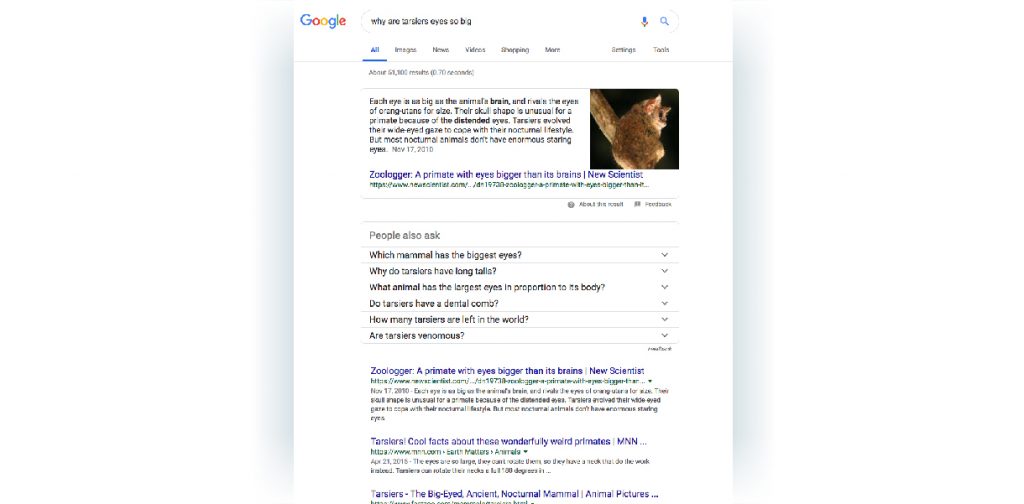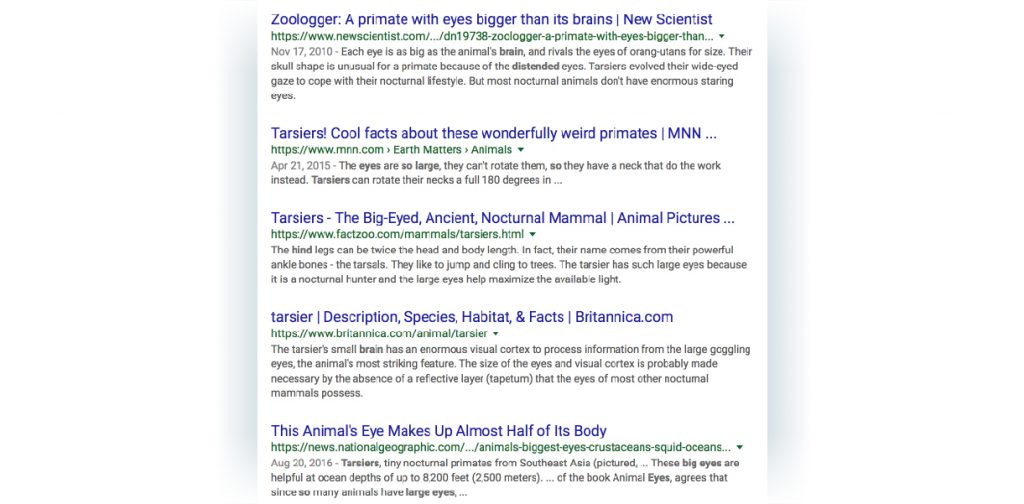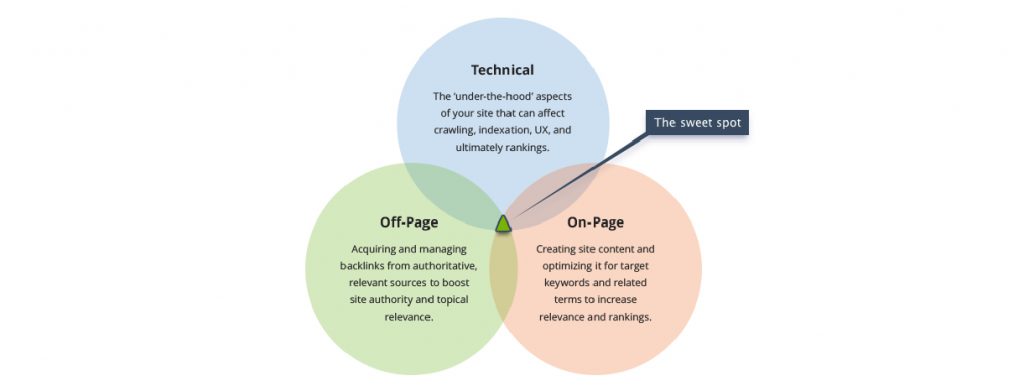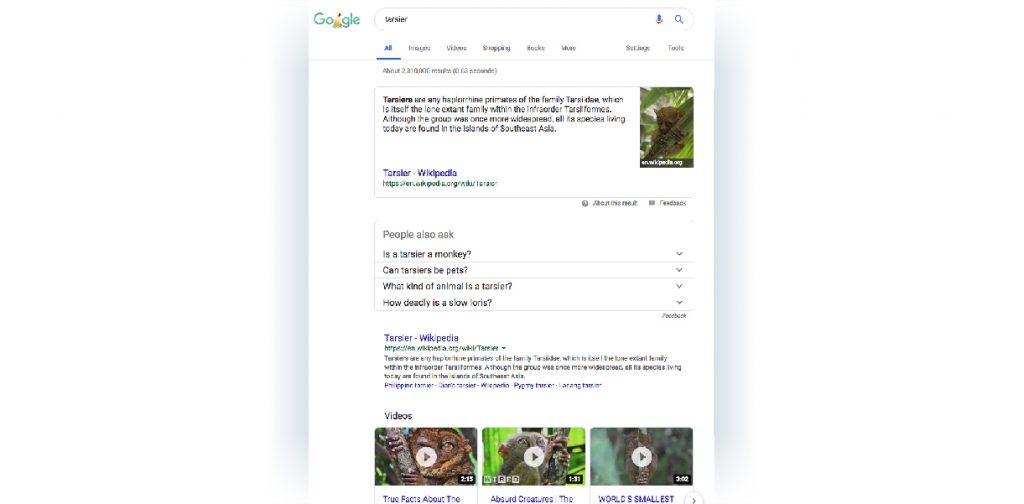- Miscellaneous

Super energetic owls? Six enchanting octagons? Silly employees objecting? Some embarrassing odors?
I’m sure you can guess that “SEO” doesn’t actually refer to any of these phrases that I just spent way too long making up.
Really, the initialism stands for “search engine optimization.” From there, I bet you can guess that SEO is either about optimizing search engines or optimizing for search engines. I’ll help you out: it’s the latter.
At this point, you might be wondering “What exactly are we optimizing for search engines?”, “Why are we optimizing it?”, “How do we optimize it?”, and “What’s Andrea’s favorite color?”
Web pages. Because we want them to be seen in search results. Through on- and off-site tactics (we’ll get into specifics later). Purple.
Here’s the deal: there are a lot of websites out there. A lot as in 1.94 billion. Plus—get this—4 million blog posts are posted every day. That’s 28 million per week. Or 112 million per month. Or 1.34 billion per year. Or 31.5 billion every 23-and-a-half years.
So, assuming I want this blog post to be seen among the other 3,999,999 blogs that were shared with the world today, how do I go about trying to make that happen?
That’s where SEO comes in.
How Search Engines Work
To understand SEO, you need a little background on how search engines work.
Basically, Google, Yahoo, Bing, Yandex, and other search engines have automated robots (also referred to as “spiders”) that “crawl” the web and index pages into these search engines’ databases.
They recall web pages when someone inputs a search query. They have to sort through the billions of web pages they’ve indexed to help us find the information for which we’re looking.
When I search “Why are tarsiers’ eyes so big?”, Google serves me up over 50,000 results across thousands of search engine results pages (SERPs).

How does it know which websites and web pages (and even pdfs and jpgs, or other files) have information about tarsier eye size? And how does it decide on the order in which to display them?
Search engines use complicated, proprietary algorithms to rank sites. Expert sources on SEO talk about the main factors involved in site ranking differently. They almost all use some variation of the words “authority,” “relevance,” “trust,” “popularity,” and “quality.”
I would boil it down to say that if a site or page is relevant to a query, provides quality information and a good experience to users, brings in a relatively good amount of traffic, has plenty of backlinks from sources around the web that are themselves trustworthy, and performs well technically, it’s got a good shot at ranking well.
The basis of SEO is that search engines want to provide a good experience for customers. The better the experience that a site or page provides, the better it will rank.
So the article “Zoologger: A primate with eyes bigger than its brains,” which appears first in the search results for my query, presumably provides a good experience. (And indeed it does. Tarsiers’ need huge eyes not only because they’re nocturnal but also because they don’t have a reflective layer behind their retinas called the tapetum lucidum, which most nocturnal animals have.)

The truth is that all of the factors that search engines use to rank sites are not 100% clear.
Search engines keep their ranking algorithms close to the vest. Plus, the algorithms have gotten much more complicated and sophisticated, to the point that rankings are based on around 200 factors.
But we have some really good ideas about which factors are most influential, thanks to some information provided by search engines and from examining the characteristics of web pages that rank well. We’ll explore some of these factors that can be optimized to improve site ranking in the “How SEO Works” section.
What’s the Point of SEO?
First, why does all of this search engine ranking stuff matter?
Because website owners want their site to show up in search results when someone enters a query relevant to their business! If you sell scuba diving watches, and someone is searching for “best scuba diving watch,” well, gee, you sure want your website to show up high in the SERP. Unless, for some reason, you don’t want to sell your watches. I don’t know your life. ¯\_(ツ)_/¯
When searching, people usually don’t look further than the first page of results, or even the first three results. If your website shows up on page 2, or 5, or 500, you don’t have as great of a chance of selling your scuba diving watches to the interested party.
Knowing how to optimize a site to be ranked well organically (without paying) by search engines is crucial if you want your web pages to be seen. Of course, Search Engine Marketing (SEM), which is paid search engine advertising, is also important. That’s a discussion for another time.
As you now know, factors like authority and relevance determine how a web page is ranked in Google. These factors are what SEO is meant to influence and, hopefully, improve. You have to know how to tell Google that your site is relevant to a particular topic, and make sure that your site is of high enough quality that users and Google give it the time of day.
I love this quote from Moz: “Although search engines have become increasingly sophisticated, they still can’t see and understand a web page the same way a human can. SEO helps the engines figure out what each page is about, and how it may be useful for users.”
It’s not enough for you to have the best answer to someone’s question or the content that’s most pertinent to their search query. If your site isn’t optimized, it may never be seen.
You’ve got to make sure search engines are able to crawl your site, and you’ve also got to make sure they’re able to understand what it’s about.
How SEO Works
So, how does one go about optimizing a site?
I’m going to give you a basic overview, focusing on these broad terms: technical SEO, on-site SEO, and off-site SEO.

TECHNICAL SEO
Technical SEO involves tactics that improve the ability of search engines to crawl and index a site.
It covers a broad range of factors that affect crawlability, performance, and security. I’ve seen it referred to as the “foundation of a site.”
When talking about technical SEO, common topics include mobile friendliness, page speed, SSL certificates, structured data markup, XML sitemaps, content optimization, and more.
It’s not separate from on- and off-site SEO, but rather intertwined with them.
ON-SITE SEO
When we talk about on-site (sometimes called on-page) SEO, we’re talking about the content and the keywords that show search engines a site is relevant to a query, as well as other on-site elements.
Keywords play a critical role in communicating what a site or page is about.
If a page has the keywords “tarsier,” “big,” and “eyes,” or the exact long-tail keyword “why are tarsiers’ eyes so big,” that’s a great indication for Google that I need to see that page to get the answer to my question.
The more specific the keywords, the better the chance a site or page has of ranking. While Zoologger ranks #1 for “why are tarsiers’ eyes so big,” when I just search “tarsier,” the search results look a lot different.

Moz for the win again: “The point of using keywords is not to rank highly for all keywords, but to rank highly for the keywords that people are searching for when they want what your site provides.”
Key point here: SEO isn’t about stuffing web pages with keywords. It’s important to focus on specific keywords and to only include them where natural in content. It’s about writing for humans, not just for SEO.
Really, websites should be designed around humans, with emphasis on easy navigation, solid performance, and clear, high-quality content. This is where further on-site factors, like page speed, mobile friendliness, site structure, etc., come in.
OFF-SITE SEO
Off-site (AKA off-page) SEO refers to link-building (getting backlinks from other websites) and other external factors that build the authority, trustworthiness, and relevance of a site.
Search engines use links to crawl the web. Links help them find and associate pages, and they also give clues about a site’s popularity. If a site has many backlinks from trustworthy or authoritative sources, that’s a clue to the search engines that it’s a quality site. That’s why, in addition to keywords, link building is one of the most important tasks for SEOs.
[UPDATE ALERT. The paragraph below was added in March 2020 to reflect an increased emphasis on building quality backlinks in SEO.]
Building backlinks first and foremost involves creating content of value (thereby earning links). But a site may need to supplement “natural” links to its content with manual link building. This involves contacting website owners and bloggers and asking them to link to your content. Manual link building must also start with valuable content that will be worthwhile for relevant sites to link to. (A quick note: Paying for backlinks or “self-creating” links by, for instance, spamming blog comment sections with links to your site or content, is frowned upon. Sites that do this can even be penalized by search engines.)
Other factors that fall under the off-site SEO umbrella, according to Moz, include social media marketing, guest blogging, linked and unlinked mentions, and influencer marketing, which all have to do with references or links to a site.
I hope that you take away some new knowledge from this blog! Competition for search ranking will never go away, so it pays to have at least a general understanding of SEO.
It’s important to note that SEO is constantly changing. What worked 10 and 15 years ago does not work anymore, and can actually penalize a site. Remember: there aren’t truly any sustainable SEO fixes that are quick and easy. To rank well, you’ve got to have a quality site.
Sources
SHARE IT!
-
Miscellaneous
Unveiling the Power of Marketing Awards: How Recognition Transforms Client Success Stories!
-
Culture
Tools of the Trade




